Are you an art and culture lover looking for unique things to do in Bali? I remember my long-ago visit to Bali on a private cruise excursion. What an overload to my senses! The natural beauty combined with elaborate architecture and a thriving arts and crafts scene was an intoxicating mix of sights, sounds, and smells.
Debi Lander of ByLanderSea, recently traveled to Bali on a multi-day trip. She shares her experience and tips for how you can explore the art and culture of this fascinating Indonesian island.
Bali calls with the allure of an exotic and enchanting tropical paradise. The country in Indonesia is known as the “Island of the Gods.”
Beauty exudes from dramatic volcanic peaks, lush emerald rice fields, beautiful beaches, and more Hindu temples than I ever dreamed possible. It’s a never-ending adventure with monkeys roaming free, gigantic Banyan trees, numerous traffic jams, and temples, temples, temples.
Table of Contents
Visit Bali for the architecture
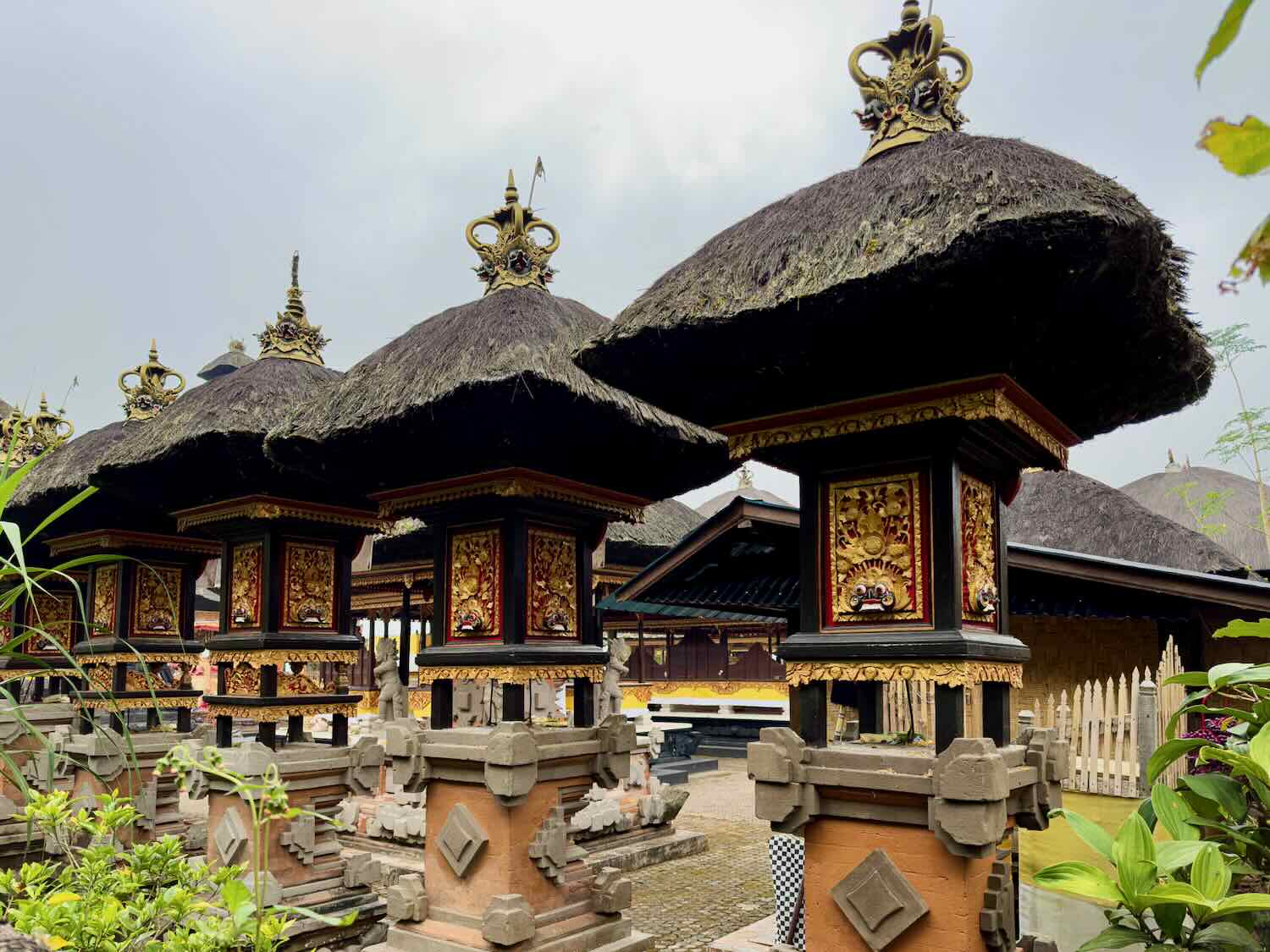
Temples are a central aspect of Balinese architecture and culture, and appear quite different than Western towns. Traditional Balinese architecture often revolves around a “compound” or a walled family enclosure.
Within this space, you’ll typically find several structures, including family homes, temples, pavilions, pagodas, kitchens, and gardens, surrounded by a wall with a central decorative gate guarded by statues. The gateway doors are intricately carved and often gilded. Some compounds incorporate lush courtyards and gardens with ponds.

The walled family compounds face the streets in villages. The roofs of the interior shrine rise above the walls. Some are tin, but more often, they are thatched in black sago palm fibers. The number of tiers in the roof denotes the deity’s rank.
Balinese architecture is known for its exquisite stone carvings and woodwork. These carvings depict mythological and religious scenes, floral motifs, and intricate patterns. They adorn temple facades, doorways, and other architectural elements.
Every village also has a main temple, a prominent ceremonial and gathering pavilion, and a drum tower to call residents.
Explore Balinese culture through arts and crafts
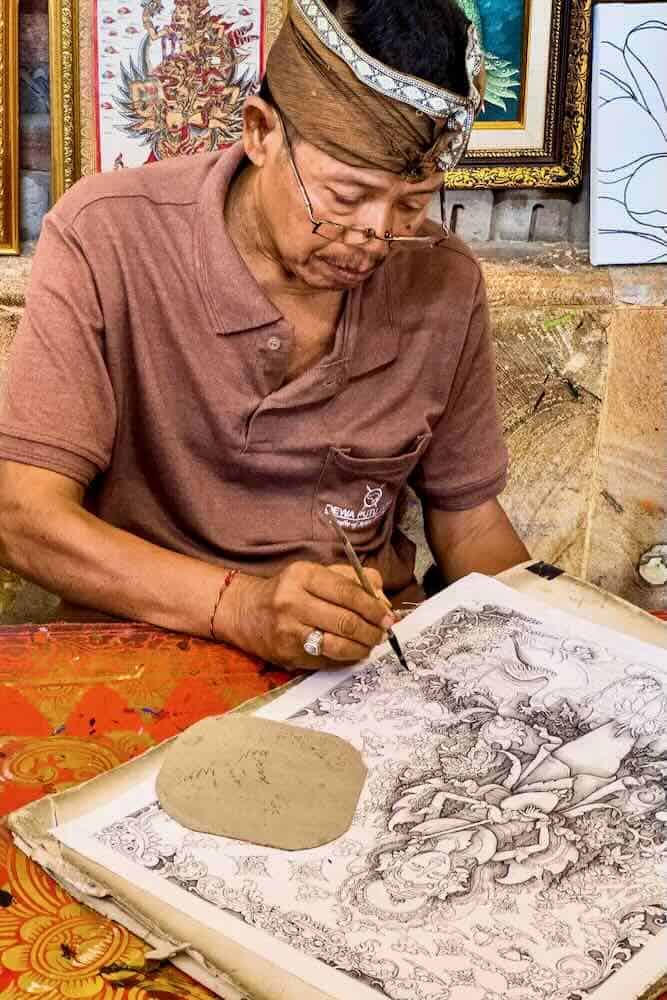
Craftsmanship is highly valued and practiced in the Balinese culture. Artisans have honed their skills for generations, creating works of art that reflect the island’s rich cultural heritage.
I participated in an arts and crafts tour, visiting skilled artisans working in their trade. An entire village is often invested in a particular art form, such as woodcarving, stone cutting, jewelry making, drawing and painting, basketry, weaving, and dying batik fabric. Extended families, often three generations, work together, the youngest learning from their elders.
At an art gallery, I watched the patriarch bent over a complex and detailed pen and ink scene. His son was painting Balinese landscapes in watercolors, and the youngest was working with vibrant acrylic paints. The art craft is evolving, but the talent is nourished in the family and communal environment.
At a Balinese wood carving studio, I watched generations working together. The artisans often hold a piece of wood between their feet when craving a statue or decorative item. Larger, elaborate carvings depicting gods, mythical creatures, and scenes from Balinese mythology adorn temples, palaces, and traditional buildings throughout the island.

The art of silver jewelry-making also maintains a long history. Skilled silversmiths meticulously create intricate designs using traditional granulation techniques. They heat small sterling pellets and tiny coiled silver wire until soft enough to adhere to a piece to form a pattern.
Their exquisite jewelry incorporates complex patterns, precious stones, and Balinese motifs. It’s hard to leave without buying jewelry or gifts.
The town of Ubud serves as the artistic hub, and the art market becomes a shopper’s delight of handmade crafts, including paintings, wood carvings, batik textiles, and silver jewelry. The narrow streets are lined with art galleries, studios, and restaurants.
Learn about Batik

Batik is a traditional fabric art that uses wax-resistant dyeing techniques to create intricate patterns on cloth. The vibrant colors and elaborate designs are integral to Balinese ceremonial attire and cultural rituals.
Many women in my tour group were quilters, especially interested in learning about batik. We visited a factory and were given some plain fabric. We dunked it into a dye bucket, then scrunched it up and drizzled on a different color dye from a squirt bottle. Finally, we sprinkled on ash, and the cloth took on a marbling effect.
A second process involved picking out a metal template with a design and dipping it into hot wax. Then, we pressed it onto another piece of wet fabric and dunked it into a different color dye. The wax prevents the dye from changing the underneath color. Afterward, the wax is boiled off, and a beautiful printed design appears on the cloth.
Many of the group wanted to purchase fabric at the factory store. The store overwhelms, and limiting the number of choices proved difficult. Some ladies filled an entire extra suitcase with their fabric.
Boomer Travel Tip
MedjetAssist Members who are hospitalized 150 miles from home receive medical transport to a home-country hospital of choice. Memberships from $99.
Visit the rice terraces in Bali

Water is critical to life on the island, and Bali’s famous rice fields use long-established man-made water channels, tunnels, and aqueducts. The rice fields are flooded and drained at precise stages of the growing cycle. The farmers use a thousand-year-old system to keep water available where needed.
Every farmer belongs to a local water-sharing association called Subak. The head of each chapter works out a planting schedule so farmers in the lower fields have access to water coming down from the mountaintop.
The beautifully shaped rice terraces are a popular tourist destination, attracting tourists and lots of photographers. Again, the communal spirit is at work, creating a profitable business.
Tourists come to overlook the fields, a glorious and memorable sight, but the community-based tourism association wisely built restrooms, snack huts, and ticket booths. They added zip lines and swings to allow tourists to interact with nature.
Visitors purchase a ticket, and other residents operate the attractions, bringing income to the area. I’ve never seen anything like it before.

I bought my ticket and took a soaring ride on my giant, Bali swing floating above the rice paddies. Memorable? You bet. I wish I’d had time to go down and hike in the fields (another paying option for tourists.)
Experience the unique cultural heritage of Bali
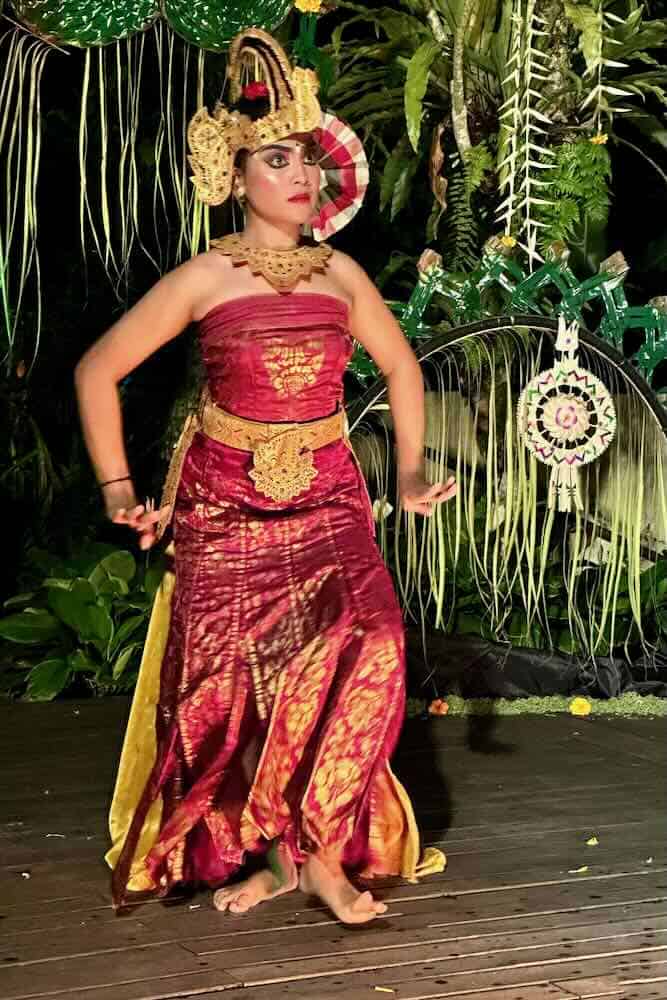
Balinese dance is a captivating form of storytelling, combining graceful movements, elaborate costumes, and expressive facial expressions. One evening, I watched an enchanting outdoor performance accompanied by traditional percussive instruments providing a mesmerizing rhythm, albeit somewhat monotonous.

I also wandered through the Sacred Monkey Forest Sanctuary in Ubud (official website), a lush jungle with gigantic Banyan trees. About 1,000 long-tailed Balinese macaques roam free, the babies mischievously frolicking. Naturally, you’ll find temples interspersed along the many walking trails of this Ubud monkey forest.
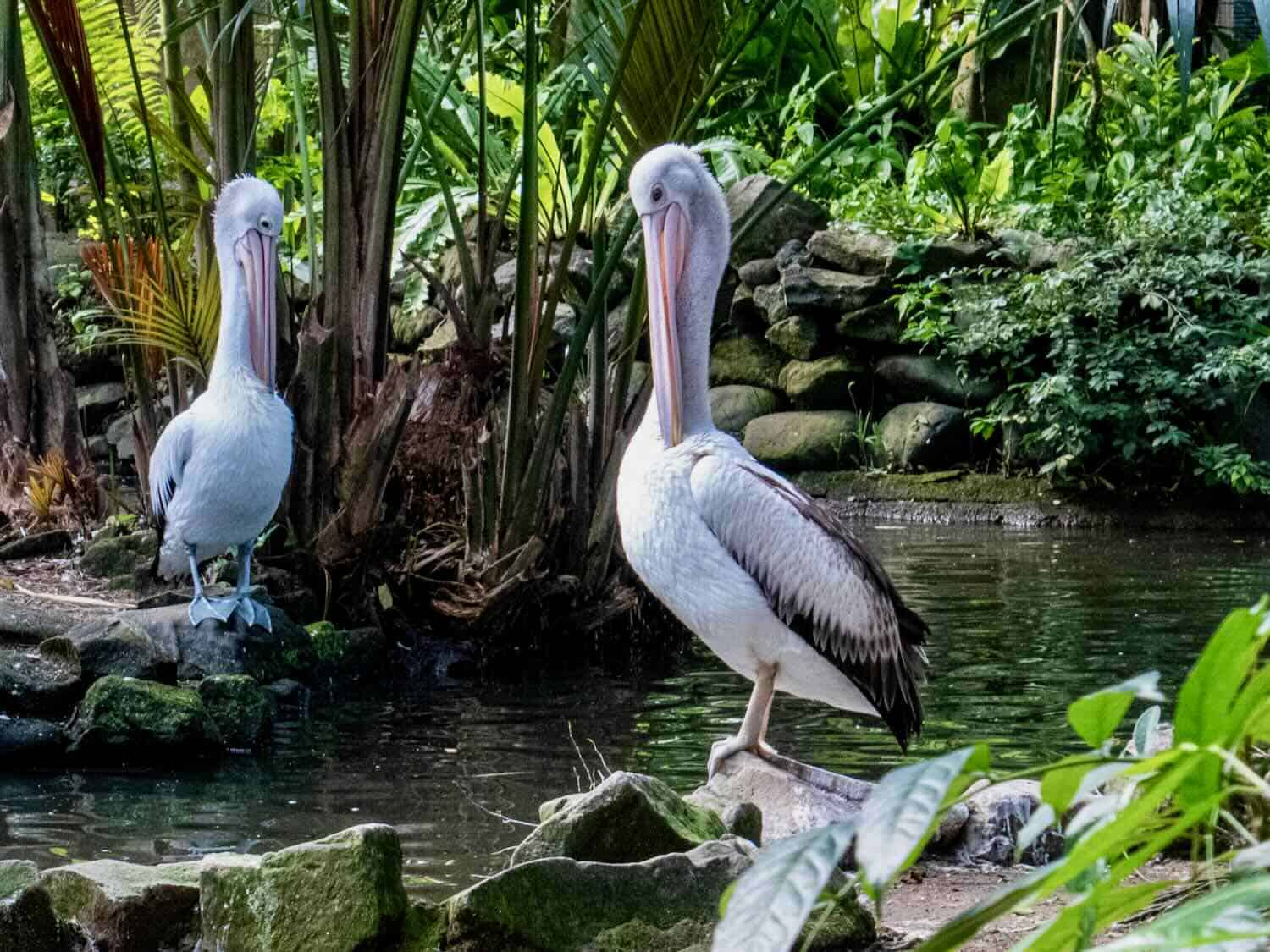
The Bali Bird Park (purchase your ticket here) proved quite impressive, with approximately 250 species of birds, including some rare types. A marvelous owl house offered a look at rarely-seen Indonesian owls. A live interactive show added fun and an educational compliment.
Try a traditional water purification ritual
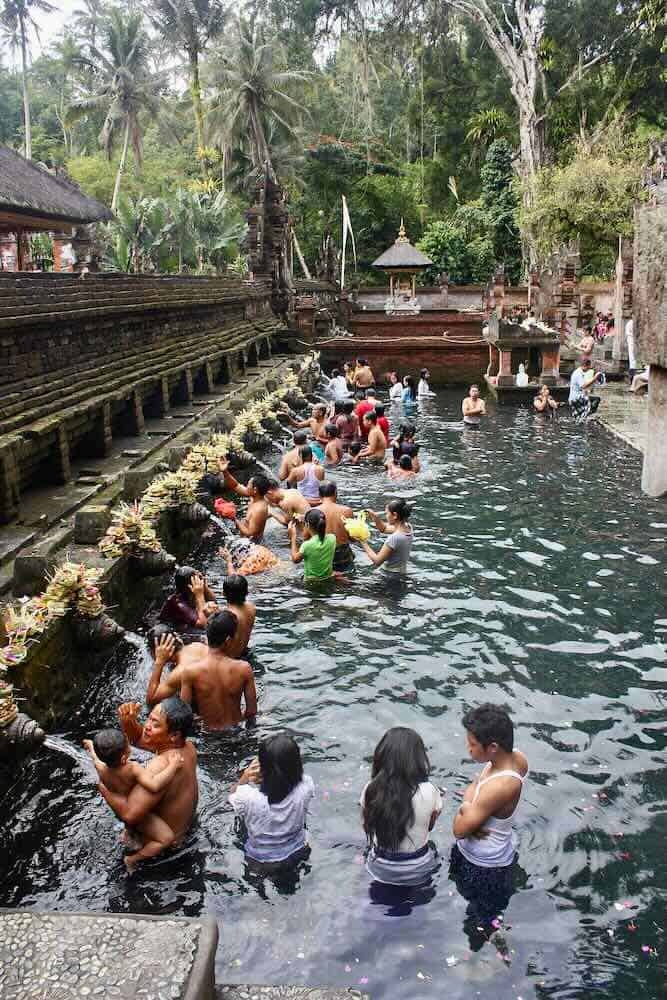
The island of Bali ranks high for wellness and yoga retreats; spa treatments come at bargain prices. I, instead, signed up to participate in a traditional water purification ritual known as a Spiritual Journey to Purification and Renewal, one of the most unique things to do in Bali.
Balinese people believe water possesses purifying qualities that cleanse the body, mind, and soul. Water rituals remove negative energies, wash away impurities, and restore harmony within oneself and the surrounding environment.
The ritual often starts with prayers and chanting led by a priest or spiritual leader. The ritual bathing ceremonies involve immersing oneself in sacred springs, rivers, or temple pools.
My group went to Tirta Empul Temple, located in the village of Tampaksiring, a renowned pilgrimage site since the 10th century. The temple stands around a natural spring, and its crystal-clear waters are believed to possess healing properties.
All participants must follow the rules and customs. Thankfully, Balinese priests guided us.
Participants first cleanse themselves and dress in a provided sari to wear in the water. Many spouts pouring forth with water line one side of the pool. We stopped at each spout to consider its significance (each was explained beforehand) and make our intent.
We poured water over our faces and submerged our heads. Each spout represents a different aspect of purification. Moving from one faucet to another symbolizes a progression toward greater purification on multiple levels.
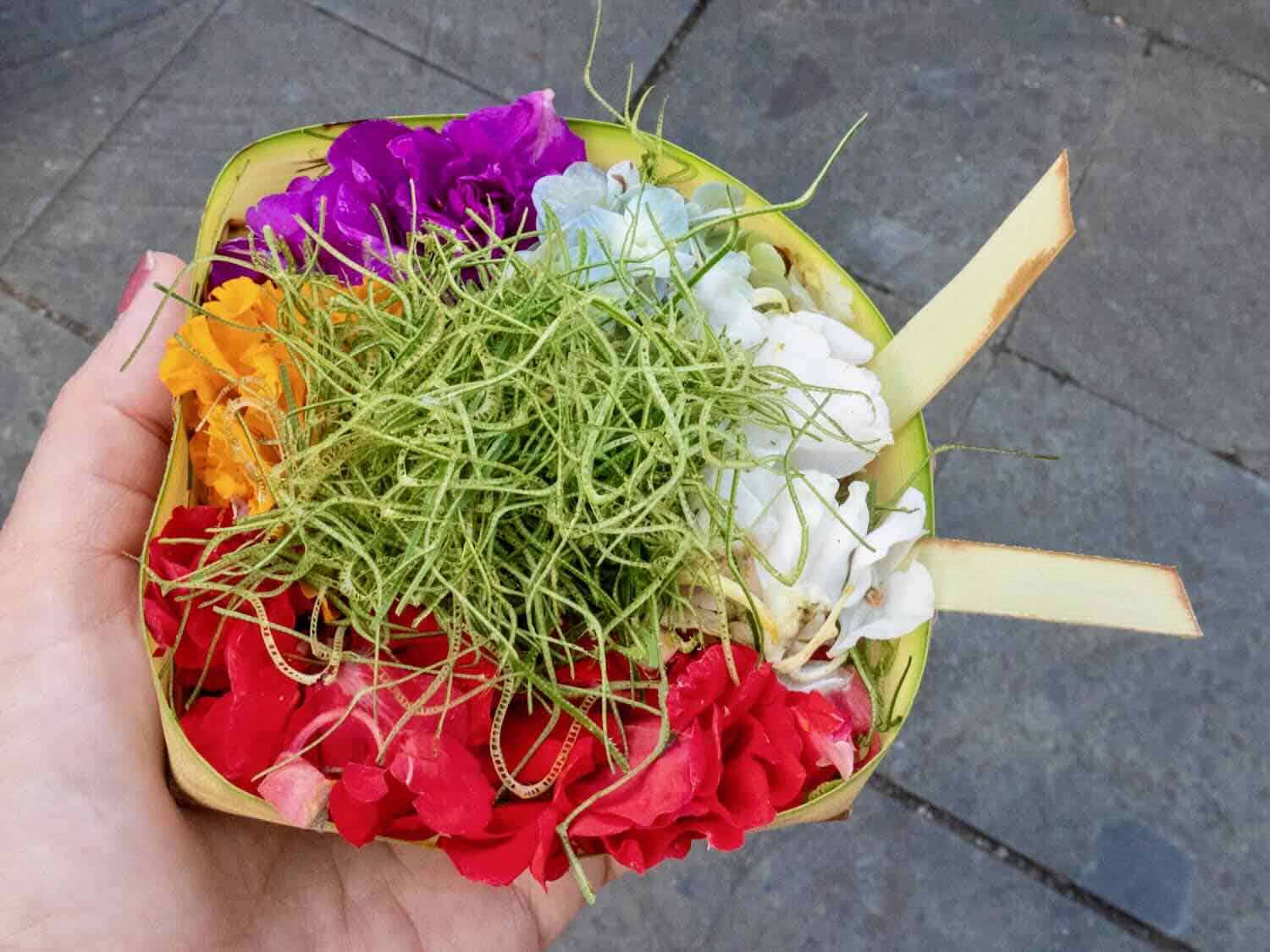
Before concluding, we made a “canang sari “offering, a small, crafted offering made from woven palm leaves and filled with symbolic items such as rice, flowers, and incense. Each element of the offering holds symbolic significance, such as rice representing sustenance, flowers symbolizing beauty, and incense signifying the connection between the earthly and spiritual realms. (We made these at our hotel for leaving for the ritual.)
We placed our offerings on an altar, and a priest continued to chant mantras and offer invocations to the deities and seek their blessings. Of course, participants may also silently offer their own prayers and intentions during this time.
Beyond its spiritual significance, the holy water ritual offers a personal journey of self-reflection and renewal. Immersing myself in the sacred waters allowed introspection, the release of negative emotions, and embracing of positive intentions.
Others said it provided a meditative space to connect with oneself, find inner peace, and embark on personal growth. For many, this is the reason they come to Bali.
Don’t miss Ulun Danu Lake Temple
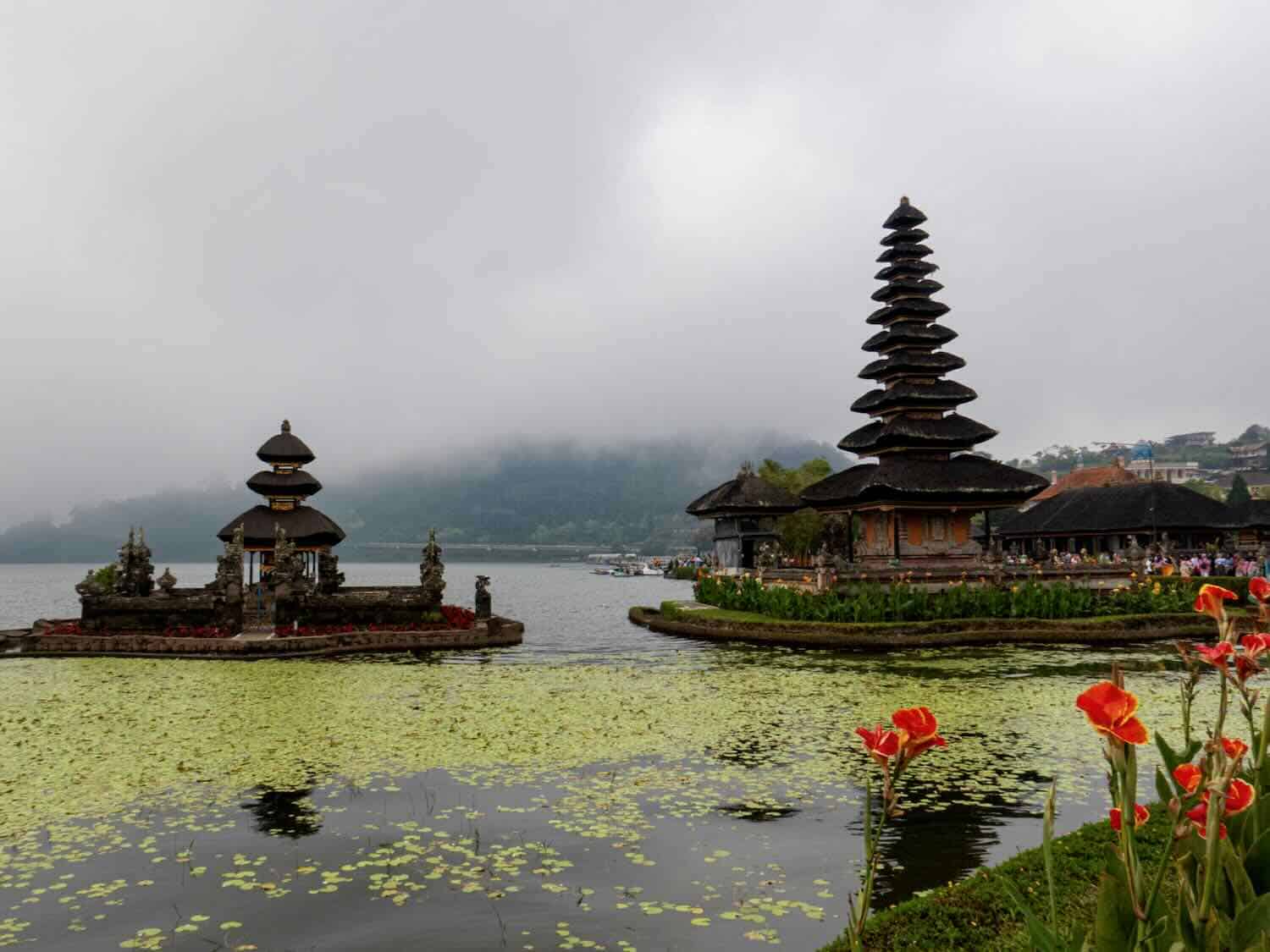
I also added a visit to the picturesque Ulun Danu Lake Temple on Mount Batur’s (an active volcano) caldera. Lake Temple is the second most important temple complex in Bali.
At Lake Temple, locals make elaborate offerings and prayers to honor Dewi Danu, the goddess of the Lake, during annual ceremonies and processions. They seek her blessings for water, fertility, bountiful harvests, and well-being.
The site includes nine temples and shrines, gardens, restaurants, and boat rides. It has become a very popular tourist site; very crowded, something I was surprised to find.
Learn to cook the Bali way
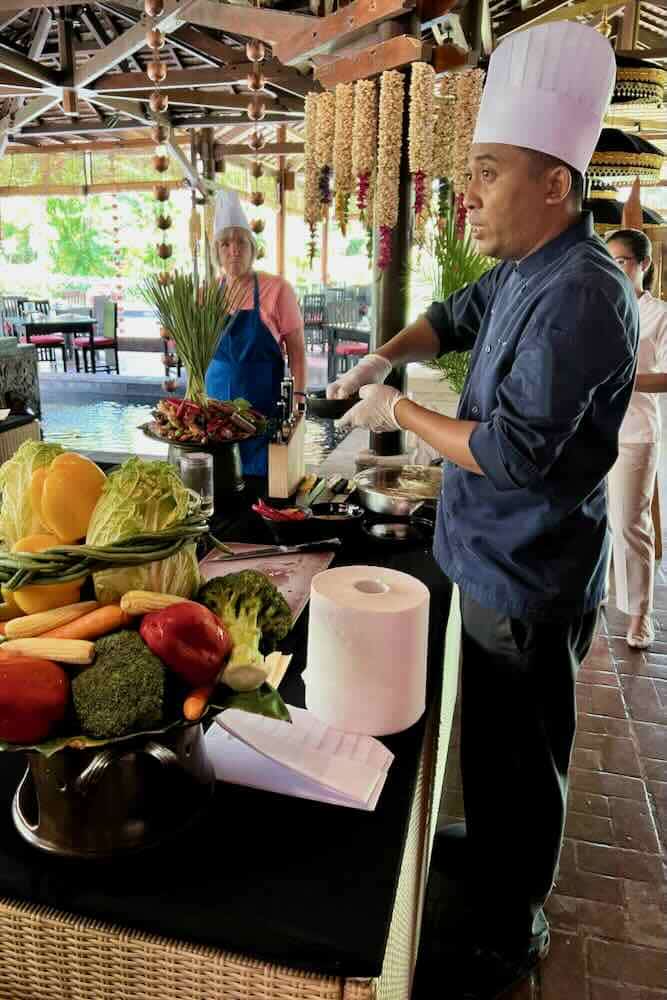
I took a cooking class, learning to make a spicy salad and satay with ground chicken cooked on a grill. Balinese cuisine is renowned for its rich, complex flavors and a combination of aromatic spices and ingredients such as shallots, garlic, chili peppers, ginger, lemongrass, and turmeric.
Where I stayed in Bali
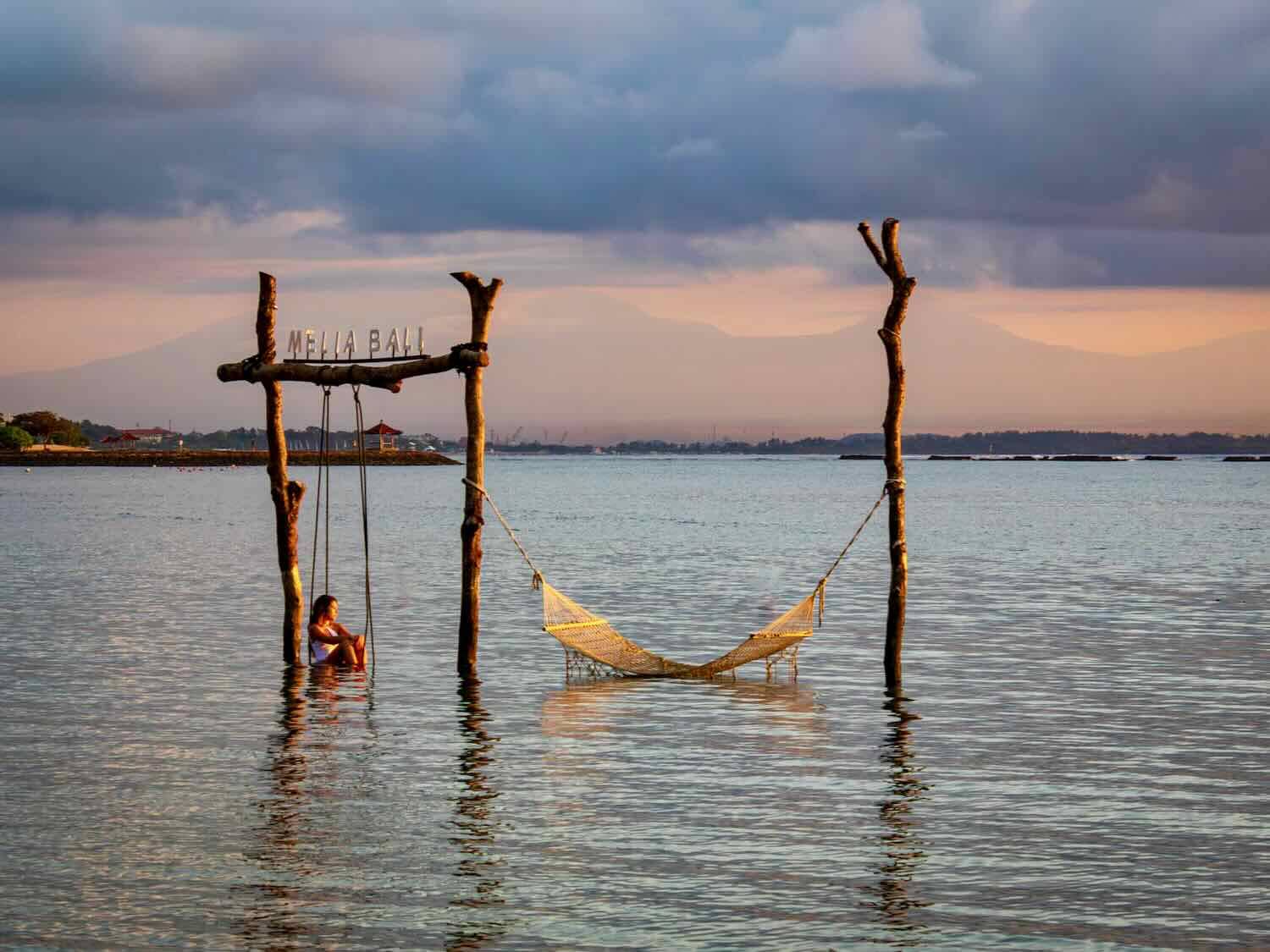
I lodged in a colorful boutique hotel in Ubud and then moved to a luxury beach resort in Nusa Dua. You can’t leave Bali without a beach day, walk or swim – and tropical cocktail.
Nusa Dua was built in the 1970s for upscale tourism with gorgeous grounds and luxurious accommodations. My hotel, the Melia, made a fitting end to my trip to paradise.
Bali is exotic, and its people are warm and welcoming, but the country gives visitors much more. I’d waited a long time to explore Bali and sadly, I left the magical island in Indonesia too soon. I hope to return someday.
Bali travel tips
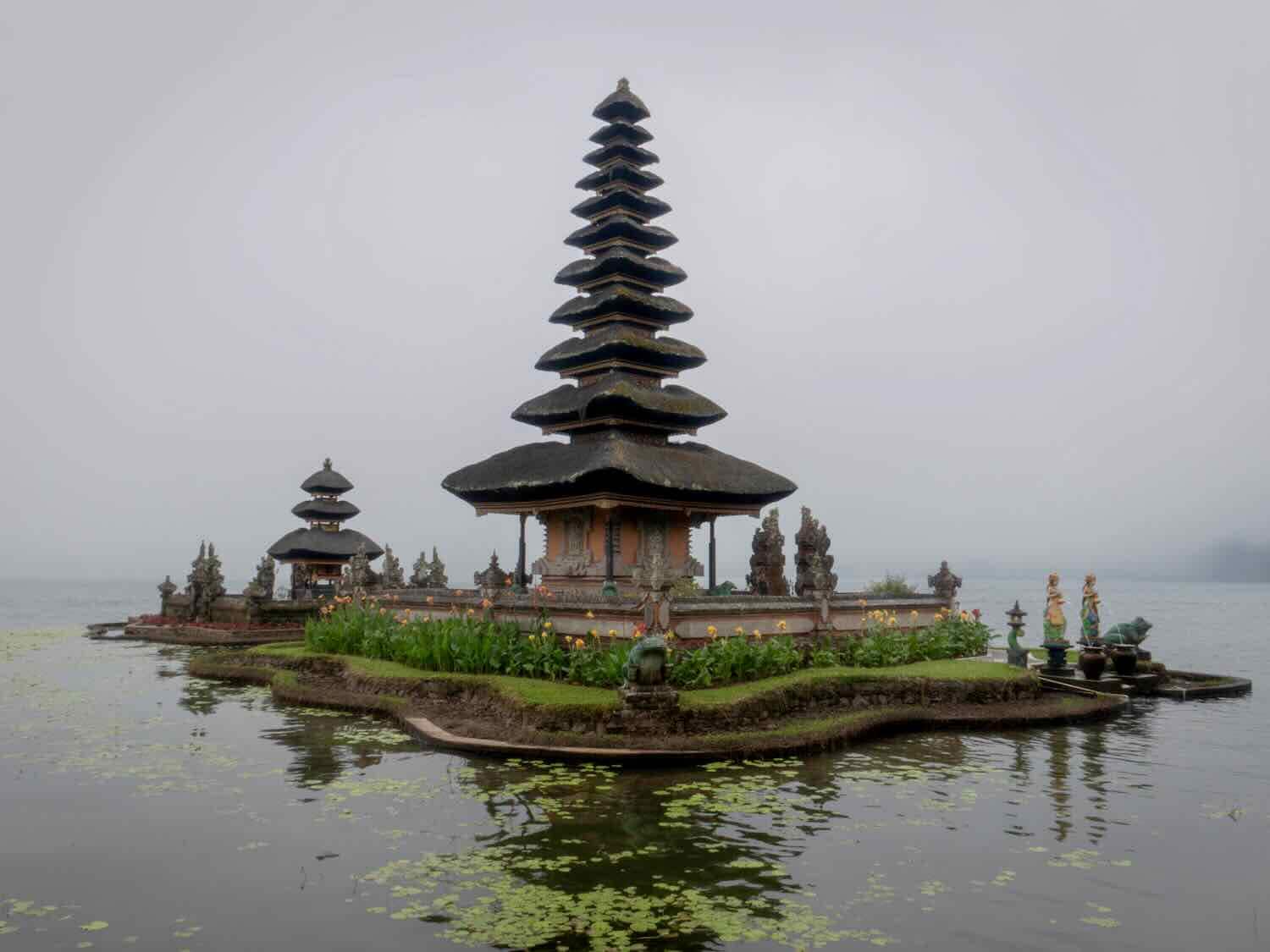
Flights to Bali will likely require stopovers; mine was in Taiwan. I kept running into Australian tourists and realized Australia lies just three hours away. You might consider combining Bali with a trip to either of those countries.
I learned about the controversial Kopi Luwak Coffee. Read about it here.
I purchased my almost all-inclusive tour from Craftours.com and highly recommend their services.
The main languages spoken in Bali are Indonesian, Balinese, and English.
The currency of Bali is the Indonesian Rupiah. You will feel like a millionaire as the exchange rate is ridiculous.
There are plenty of ATMs in Bali’s main cities Most restaurants and shops accept cards, but cash is preferred.
The plugs in Bali are type C and F. The standard voltage is 230 V, Bring a universal adapter.
Bali is one of the safest destinations for solo female travelers! The biggest thing you need to watch out for is road safety, especially if you’re renting a motorbike. Take a taxi if you’re not a confident rider. It will always be cheaper than a hospital bill.


